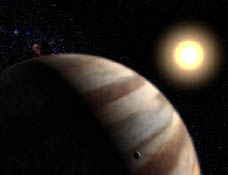There's a time in every child's life when she wonders whether she was adopted. Maybe she doesn't look like other family members, or has a different personality. Is she secretly royalty? A freak of nature? Or is she a normal family member after all?
Of the almost 300 planets discovered outside our solar system, most are "hot Jupiters" — gas giants circling their stars so closely that no sunscreen will save them. Of course, we know of so many because these are the easiest kind of planet to discover. But the numbers set astronomers wondering: is our solar system, with its inner terrestrial planets and outer Jovians, really a normal member of the cosmic family?

Artist's depiction of an exoplanet (and moon) around a red dwarf star.
D. Aguilar / CfA
A team of astronomers speaking at an International Astronomical Union (IAU) symposium in Boston last week may have an answer. Using the European Southern Observatory's HARPS spectrometer at La Silla, Chile, they found evidence that around Sun-like stars, lower-mass "Neptunes" and "super-Earths" may outnumber Jupiter-mass planets by 3 to 1.
The presentation, given by Christophe Lovis (University of Geneva), described preliminary evidence for 45 low-mass planet candidates, all at or below 30 Earth masses (a tenth of a Jupiter), according to their press release. Eight of the possibilities weigh in at just 4 to 10 Earth masses. These qualify as super-Earths and likely have solid, rocky surfaces. Larger candidates may be Neptune-like "ice giants" (the term is used regardless of temperature), with massive hydrogen-helium atmospheres and a bulk composition of mostly water, methane, and ammonia.
"This really changes things," says Sara Seager (Massachusetts Institute of Technology), who attended the Boston meeting. "It marks the beginning of the detailed exploration of super-Earths."
All the planet candidates orbit their stars within 50 days. Given these tight orbits close to their stars, none can support liquid water on or near their surfaces.
Micro-Wobbles
The astronomers studied several hundred Sun-like stars, ranging from 0.7 to 1.2 solar masses. They looked for tiny radial-velocity changes — stellar movements due to the gravitational pull of orbiting planets. Just as a star tugs on a planet, the planet tugs back, and so the star performs a miniature mirror-image of the planet's orbit. The star's movement, amounting to mere meters per second, shifts the wavelengths of the star's spectral lines back and forth slightly. Only in the last decade or so have specialized spectrometers been able to measure such tiny velocity changes.
Astronomers have assumed that this method will work only up to a point. For radial-velocity changes less than about 1 meter per second, other factors such as motions in the star's surface and interference by Earth's atmosphere appear to drown out planetary effects, no matter how good the instruments. That would leave Earth-mass planets forever beyond the reach of the radial-velocity method. For instance, Earth itself produces a wobble in the Sun of only 0.09 meter per second around the course of a year.
Nevertheless, the possibility exists to break the 1-meter-per-second limit, writes Seager. Planet hunters are working hard to achieve this.
Back to the Drawing Board?
The HARPS astronomers have not released the locations or names of their 45 potential planets because the findings remain unconfirmed. "These are preliminary numbers," says Lovis. "But there's no doubt that the majority of them will turn out to be real."

A Jupiter-like exoplanet closely orbiting the star HD 209458 (artist's concept).
Given the sample population's size and the number of possible discoveries, the statistics imply that 30 percent of roughly Sun-like stars come with hot Neptunes or super-Earths. This estimate surprises astronomers like Seager. With 10 percent of solar stars already believed to host hot Jupiters, "that means that 40 percent of Sun-like stars have planetary systems very different from our own," Seager told Science News. "And that is sobering."
Why?
True, if the trend continues to even lower-mass planets, Earth analogs would be not just common, but abundant. Most stars would have them.
On the other hand, if 40 percent of stars have solar systems that look nothing like ours, astronomers' models for planet formation may be wrong. The disheartening possibility is that our solar system — with its lovely, 1-Earth-mass world where astronomers can come into existence and study a planetary system close up — is a rare peculiarity that has led astronomers astray in their theories of planet formation and evolution.
Still, the possibility of multiple super-Earths excites astronomers. "All I can say is that the 11 planet candidates that Christophe Lovis showed at the conference last week looked very promising," writes Seager. "Time will tell."
 1
1









Comments
TexLex
May 31, 2008 at 1:10 pm
Note that the gravity on the surface of the super-Earths will not be proportional to their masses, because their radii will also be larger. Back of the envelope, mass (M) will scale with volume, volume scales with the cube of the radius (R): M -> R^3 or R -> M^(1/3). Surface gravity scales as as M/R^2 = M/M^(2/3) = M^(1/3). So a 4-Earth planet would have a surface gravity of 1.6 g, a 10-Earth one 2.15 g. All in all pretty Earth-like, though you'd want to wear arch supports.
You must be logged in to post a comment.
You must be logged in to post a comment.